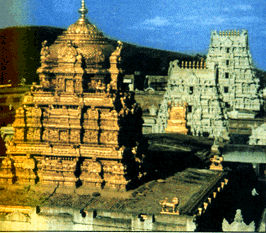
A HINDU TEMPLE (DEVAALAYA)
M.G. Prasad, Hindu Temple and Cultural Society, Bridgewater, New Jersey

M.G. Prasad, Hindu Temple and Cultural Society, Bridgewater, New Jersey
Introduction:
The origin of the word temple can be traced to word the "templum" which were used by Roman soothsayers indicating a section of the sky and also a piece of the ground to gaze and mark divine signs for foretelling the future. Eventually, temple referred to a building constructed at the site. A Hindu temple refers to in Sanskrit language to Devaalaya consisting of two words namely Deva (God) and Alaya (House).
Purpose:
In Vedic Hindu view, an individual's body is referred as a temple with the indweller as God. The Vedic seers (Rishis) having realized God within themselves gave designs and functions of temples in scriptures (agama shastras) of Vedic Hinduism (Sanatana Dharma). Its purpose is to enable a devotee to use a physical temple and the ritualistic worship as a reminder to the spiritual journey to be carried out within oneself. In addition, it also serves as a place for celebrations of Hindu religious festivals.
Architecture:
A Vedic Hindu temple's architecture is a divine and yogic representation of a human being as shown in the figure (ref: Agama kosha by S.K. Ramachndra Rao). The feet represent the spire (rajagopura). The hands represent the walkway (prakaara) encompassing all around the temple. The main hall (mandapa) represents the abdomen. The entrance porch (antaraala) represents the heart. The sanctum sanctorum (garbha griha) represents the head. The deity is consecrated with religious rites in the sanctum sanctorum. There is proportionality between the size of the deity in the sanctum sanctorum and the sizes of the temple construction details.

Worship Rituals:
The ritualistic worship (pooja) of consecrated deities (vigrahas) is carried out by priests on behalf of devotees to remind them of the inward yogic process of approaching the indwelling God. The various steps in a pooja offered to the deity with prayers and mantras (in Sanskrit) include steps such as washing feet and giving sacred bath using milk and water. Then with screen closed the deity is decoratively dressed with special cloths, flowers and ornaments. After the decoration the screen is opened to devotees to signify removal of veil of illusions so that devotees can see the beautifully decorated God. Then fruits and food are offered and incense sticks and lamps are waved to the deity. During the waving of lamp by a priest, devotees need to see with eyes open the radiating face of the fully decorated deity so that its memory will provide the spiritual joy. Then the priests distribute the sacred water (teertha) and sacred food (prasada) that devotees drink and eat for spiritual blessings. Thus the entire ritualistic worship can also be seen as expressing love, devotion and respect to one's guest of honor. The joyful resonance between the external and internal worship provides the bliss.
The elaborate worship of consecrated deity along with sacred rituals with Vedic mantras and the materials used in rituals such as water, milk, flower, incense, sandal paste, bells, conch-shell etc is to help devotees to focus their mind on the Supreme Being. The Vedic seers have recommended the temple and rituals so that devotees through sensory experiences can spiritually experience the bliss of God. It is inspiring to remember the words of my Sadguru Sriranga, a seer-yogi, "The worship of deities and rituals in a temple should be carried out with child-like loving mind by the devotees as little children play with joy using their toys as medium.
Role in Vedic Hinduism:
Vedic Hinduism or Santana Dharma is based on the Vedas and Vedic literature. Solutions and approaches to all levels of inquiry into the nature of soul, universe and God are provided in Vedic Hinduism. Rituals, Music, Dance, Yoga, Meditation, Vedanta etc express its many facets. The celebrations of Vedic Hindu festivals bring out the various aspects namely religious, cultural, educational and social. A devotee focusing on the meaning of the Vedic mantras and ritualistic procedures will gain the spiritual knowledge. One focusing on the prayers and feelings in rituals will experience joy of devotion. One focusing on service in a temple will experience the joy of selfless service.
A temple plays an important role in providing a sacred place and means for spiritual development of a seeker.
Concluding Remarks:
A
Hindu temple (Devaalaya) has not only religious purpose but also spiritual,
cultural, educational and social objectives. It provides a place for devotees
to focus and develop their spiritual insight. A Hindu temple in essence
can be recognized in three forms. The first is oneself with God within.
The second one is a dedicated room (with altar and deities) in a home.
The third one is the Hindu temple in which devotees participate collectively
that reflects the pluralistic nature of Vedic Hinduism or Santana Dharma.
Thus a devotee needs to integrate all the three forms of temples to develop
the spiritual insight and enjoy the peace and bliss.




